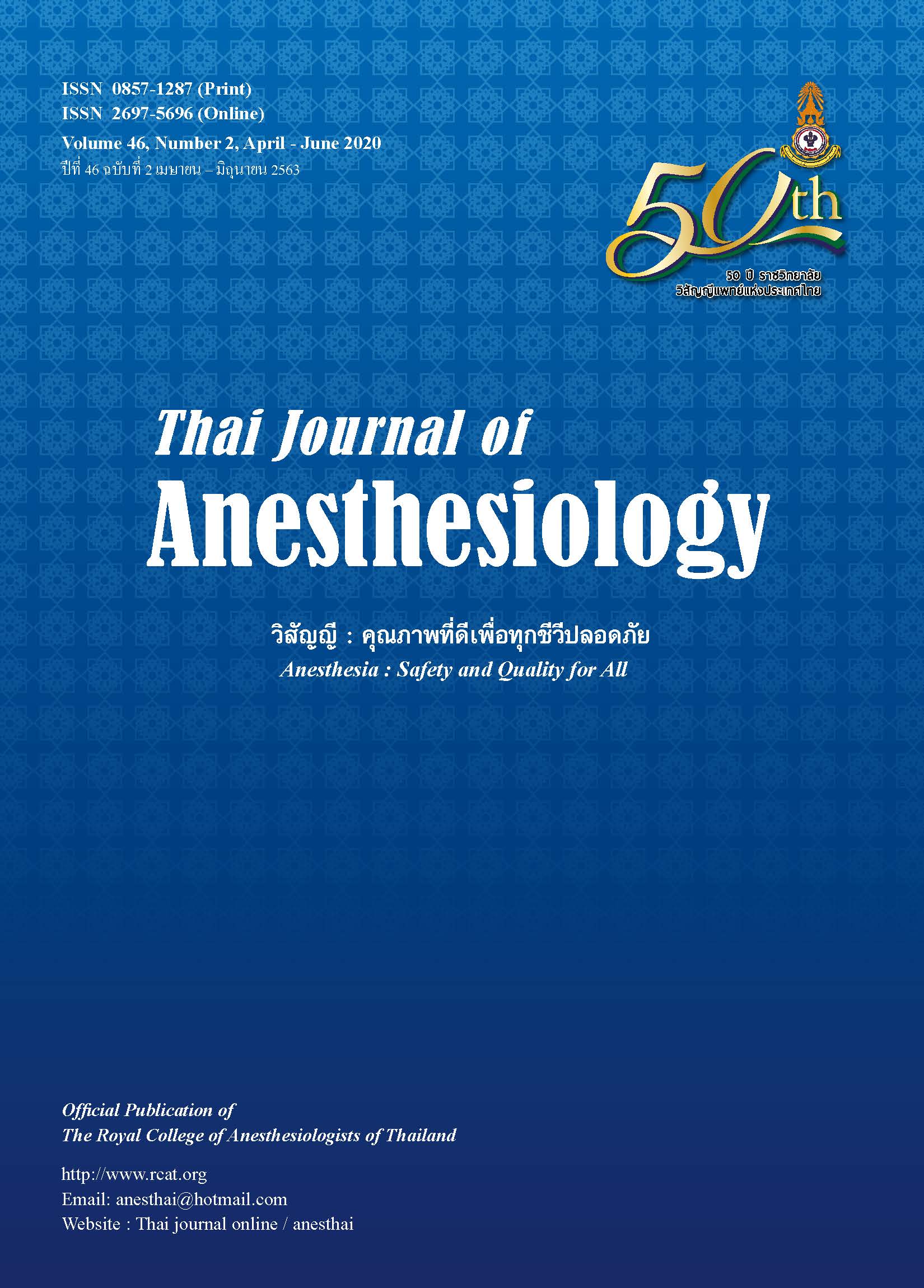Cardiac Arrest in the Operating Room: Problems of Care by Nurse Anesthetists
Main Article Content
Abstract
Background: Cardiac arrest in the operation room is an
emergency condition in which appropriate care can
increase the survival rate. Nurse anesthetists play an
important role in cardiopulmonary resuscitation.
Objectives: To study the problem of nurse anesthetist
during cardiac arrest care in operating room including
associated factors.
Methods: The study is a prospective, descriptive study
conducted at the Department of Anesthesiology, Faculty
of Medicine, Khon Kaen University. The participants were
nurse anesthetists. Specific questionnaire was decided to
study the problems and cause of problems in cardiac arrest
care in operating room including associated factors.
Results: The response rate was 54.7 %. The most
commonly cited problem was defibrillator using. Other
common problems were communication, resuscitation
form and drug administration. The underlying causes were
the lack of awareness of guidelines, inadequate number
of equipment, lack of practical experience and refresher
courses.
Conclusions: Our study found many problems during
cardiac arrest care in operating room. These findings could
be helpful in developing nurse anesthetist workflow
management and the care of cardiac arrest in the
operating room.
Article Details
References
operating room: resuscitation and management for the
anesthesiologist: Part 1. Anesth Analg 2018;126:876-88.
2. McEvoy MD, Thies KC, Einav S, et al. Cardiac arrest in the
operating room: Part 2-special situations in the perioperative
period. Anesth Analg 2018;126:889-03.
3. Callaway CW, Soar J, Aibiki M, et al. Part 4: advanced life
support: 2015 International consensus on cardiopulmonary
resuscitation and emergency cardiovascular care science
with treatment recommendations. Circulation 2015;132:S84-
S145.
4. Link MS, Berkow LC, Kudenchuk PJ, et al. Part 7: Adult
advanced cardiovascular life support: 2015 American Heart
Association guidelines update for cardiopulmonary
resuscitation and emergency cardiovascular care.
Circulation 2015;132:S444-64.
5. Nunnally ME, O’Connor MF, Kordylewski H, et al. The
incidence and risk factors for perioperative cardiac arrest
observed in the national anesthesia clinical outcomes
registry. Anesth Analg 2015;120:364-70.
6.Newland MC, Ellis SJ, Lydiatt CA, et al. Anesthesia-related
cardiac arrest and its mortality: a report covering 72,959
anesthetics over 10 years from a US teaching hospital.
Anesthesiology 2002;97:108-15.
7. Charuluxananan S, Suraseranivongse S, Jantorn P, et al.
Multicentered study of model of anesthesia related adverse
events in Thailand by incident report (The Thai Anesthesia
Incidents Monitoring Study): results. J Med Assoc Thai
2008;91:1011-9.
8. Hinkelbein J, Andres J, Thies KC, et al. Perioperative cardiac
arrest in the operating room environment: a review of the
literature. Minerva Anestesiol 2017;83:1190-8.
9. Runciman WB, Morris RW, Watterson LM, et al. Crisis
management during anaesthesia: cardiac arrest. Qual Saf
Health Care 2005;14:e14.
10. Bunthaothuk S, Boonmak P, Boonmak S, et al. Cardiac arrest
care improvement for nurse anesthetist at Srinagarind
Hospital: action research. Journal of Nursing and Health Care
2017;35:235-42.
11. Flin R, Patey R. Non-technical skills for anaesthetists:
developing and applying ANTS. Best Pract Res Clin
Anaesthesiol 2011;25:215-27.
12. Lyk-Jensen HT, Jepsen RM, Spanager L, et al. Assessing
nurse anaesthetists’ non-technical skills in the operating
room. Acta Anaesthesiol Scand 2014;58:794-801.
13. Kleinman ME, Perkins GD, Bhanji F, et al. ILCOR Scientific
knowledge gaps and clinical research priorities for
cardiopulmonary resuscitation and emergency cardiovascular
care: A consensus statement. Resuscitation 2018;127:
132-46.
14. Boonmak P, Boonmak S, Chogarunngamsang W, et al
Advance cardiac life support knowledge among medical
staff and residents in university hospital. Srinagarind Med J
2009;24(4) 296-301.
15. Daenseekaew S, Saensom D, Singha-Dong N, et al. Nursing
practice environments in northeast Thailand. Journal of
Nursing and Health Care 2017;35:216-26.
16. Fanning RM, GABA DM. Principle of anesthesia crisis
resource management. In Gaba DM, Fish KJ, Howard SK,
Burden AR, editors. Crisis management in anesthesiology.
2nd ed. Philadelphia: Elsevier Saunders. 2015: p.25-53.
17. Poomsawat S, Srichaipanha S, Boonmak P, et al. Evaluation
of an ACLS training program for nurse anesthetist aims at
role and satisfaction. Srinagarind Med J 2004;19:198-04.


